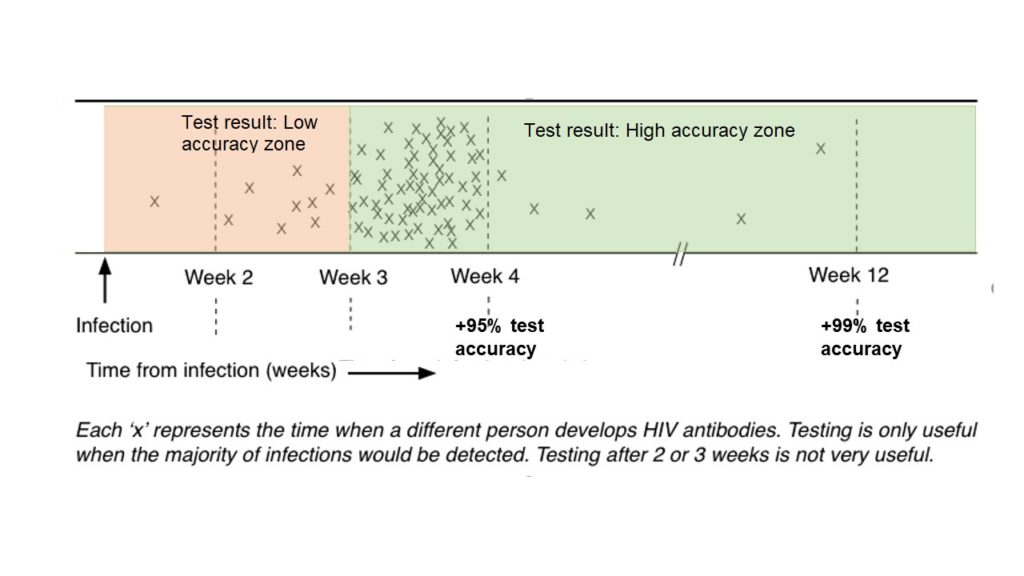A Non-Reactive result means that the test did not detect HIV antibodies in your blood. However, in some cases, HIV infection cannot be ruled out completely. Thus, it is advised to go for HIV testing once again after 3 months of testing to confirm the serostatus.
Hence, 4th Generation HIV test(antibody/antigen) is recommended it has an accuracy of 95% if tested within 28 days of infection and 99.99% if tested in 3 months.
Often people confuse with the terminologies used in describing HIV test results. There are basically one of 3 types of test results one expects after getting tested for HIV antibody tests.
Those are as follows
- Invalid: It means that the test did not work properly and it will have to be repeated.
- Reactive: This is considered as a preliminary positive, and means that HIV antibodies were found.
- Non-reactive: means no presence of HIV antibodies detected (however in few cases it was observed that the patient has contracted HIV even after Non-reactive test results)
So what’s with the Non-reactive test? Why HIV test result has the term ‘Non-reactive’?
To understand this, we need to first understand the effects of the HIV virus on our immune system.
Understanding the effects of HIV on the immune system
HIV infection is caused by the human immunodeficiency virus. HIV which is human immunodeficiency syndrome affects the immune system of the affected person. The immune system helps the body fight off infections. Antibodies are produced by the body, to fight this infection. If left untreated can cause the CD4 cells to damage. CD4 also known as T cells when gets killed over the time causes further chances of infection and the patient is more likely to get various types of infections and cancers.
To fight against HIV infection, our body produces a specific or special kind of antibodies.
HIV antibody/antigen test detects the presence of these antibodies to detect the virus, thus they look out for the effect of HIV virus on the body then the virus itself. (Barring Antigen test, it looks out for P24 a protein which is a part of HIV virus). The first HIV protein (antigen) that can be measured is P24 (from 1 to 8 weeks after exposure).
Thus only, ‘HIV antibody/antigen test’ has these terminologies such as ‘Reactive’ ‘Non-reactive’ test result as explained above
So coming back to the question ……
Do you think non-reactive (HIV result) and negative the same thing?
No, it’s not. The HIV antibody/antigen test detects the special antibodies produced exclusively by the immune system to attack the HIV virus. Thus, the presence of these antibodies marks the presence of these HIV in the system. HIV test result indicates ‘Non-reactive’ usually means that a person is HIV negative. However, in rare cases, a ‘Non-reactive’ test result may be a false negative. A false-negative test result occurs when the test shows negative and the person, in reality, is HIV positive.
In what condition a ‘Non-reactive’ test result may be a false positive?
A non-reactive HIV test means that there are no detectable HIV antibodies at that time of taking the test. This may not be the case and HIV virus may leave undetected due to the window period.
Window period
The window period is the time between potential exposure to HIV infection and the point when the test will give an accurate result. Thus, the test result accuracy may vary when tested out of the window period.
As mentioned previously the ‘4th Gen Antibody/Antigen test’ has an accuracy of 95% when tested during 4 weeks of exposure and 99% when tested after 3 months of exposure. Thus, the window period for the 4th Gen Antibody/Antigen test is 4 weeks.
Thus, the test result may be inaccurate when tested out of the window period.
Why the window period in HIV testing is so crucial?
For a test to be accurate and to avoid false-negative test results, it is essential that to test after 4 weeks for a very accurate result. As it can be seen from the fig below the maximum viral load (represented by the cross) happens between 3rd and 4th week of exposure. Viral load is the term used to describe the amount of HIV in your blood.

As it can be clearly seen the rate of the viral load inside the body is at its peak between Week 3 and Week 4, thus the amount of virus in the blood is to the fullest after week 4. After week 4 it (viral load) continues to add in the blood and thus the accuracy of the test increases beyond 95%.
The first HIV protein (antigen) that can be measured is P24 (from 1 to 8 weeks after exposure).
This indicates that Viral load and p24 tests are not accurate or non-conclusive for diagnosing during the early HIV stage. So, if the results are negative there are chances that it is a false negative result. Thus, an HIV non-reactive test result may appear between Week 2 to Week4 requires a confirmatory test after 3months.
Non-reactive HIV test range
Generally, the non-reactive test result means the patient is HIV negative. However, the probability of having a false-negative test result diminishes 12 weeks after exposure.
HIV non-reactive after 3 months indicates there is a 99.99% chance that you are HIV negative. HIV non-reactive after 1 year clearly indicates the patient doesn’t have the HIV virus inside his body.
Testing from a reliable source thus forms a very essential part of diagnoses. What’s more required if you find a reliable and trusted STD testing partner near your place.
You have multiple options to get tested for HIV with discounted rates, just check out the links below


